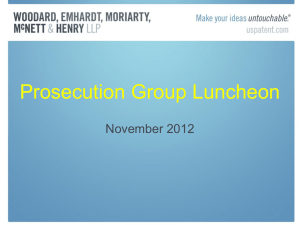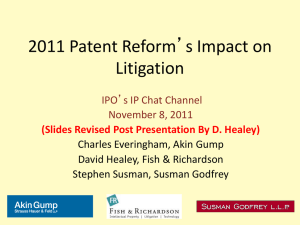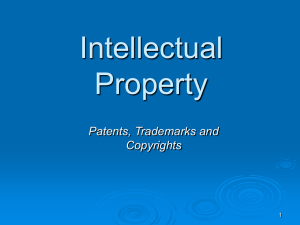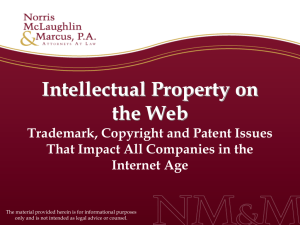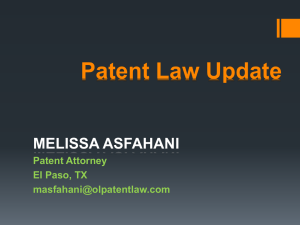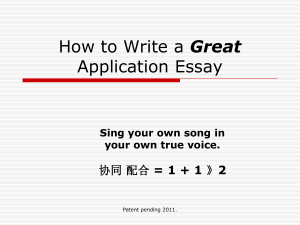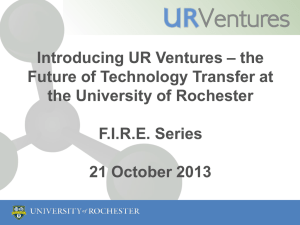BHS Brief Introduction to IP Strategy in US
advertisement
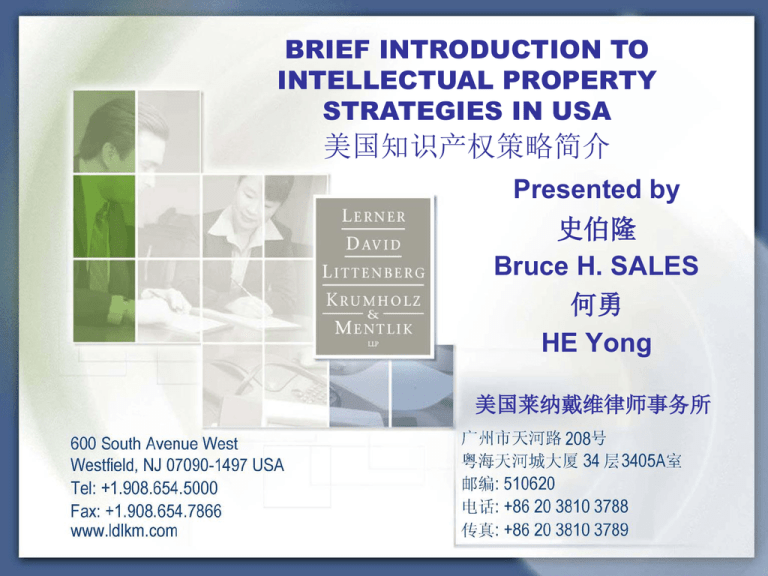
BRIEF INTRODUCTION TO INTELLECTUAL PROPERTY STRATEGIES IN USA 美国知识产权策略简介 Presented by 史伯隆 Bruce H. SALES 何勇 HE Yong 美国莱纳戴维律师事务所 Who is Lerner David? 莱纳戴维是谁? Intellectual property specialty law firm – Litigation – Licensing – Transactions – Due Diligence – Strategies for US and worldwide – Patent and Trademark procurement 一家专注于知识产权的律师事务所 – 诉讼 – 知识产权许可 – 知识产权交易 – 尽职调查 – 在美国以及世界范围的知识产权策略 – 专利以及商标注册申请 2 Who is Lerner David? 莱纳戴维是谁? 80 IP attorneys; 25 partners – All attorneys dual qualified as attorneys-at-law and patent attorneys – Our Firm • Tier 1 Firm (Chambers) – Our Partners • Leading IP lawyers in the USA (Chambers) • International Law “Super Lawyers” (Corporate Counsel) 80名各个领域的专职知识产权律师,25名合伙人 – 所有的律师均具有双重律师身份,均为专利律师; • 我们的律所为美国一类律师事务所 – 我们的合伙人 • 均为美国一流的著名知识产权律师 • 我们的合伙人被评为国际法超级律师团队(公司法律顾问) 3 Who is Lerner David? 莱纳戴维是谁? – Our Partners (Continued) • Preeminent Lawyers in U.S. (LexisNexis) • Best Lawyers in America – 我们的合伙人 (续) • 我们的合伙人被美国LEXISNEXIS评为全美卓越律师团队 • 美国最卓越的律师 4 Who is Lerner David? 莱纳戴维是谁? Our legal practice – 50% adverse matters • Patent litigation • Trademark litigation • Trademark oppositions and cancellations • Patent oppositions • Infringement allegations 我们所涉足的领域包括: – 50%对抗性案件 • • • • • 专利诉讼 商标诉讼 商标异议和商标无效 专利权异议 侵权申诉 5 Who is Lerner David? 莱纳戴维是谁? Our legal practice (Continued) – 50% non-adverse matters • Licensing (drafting and negotiating) • Strategy creation and implementation worldwide • Patent opinions on infringement and validity • Due diligence analysis • Patent searching, writing and prosecuting worldwide • Trademark selection, clearance and prosecution worldwide 我们所涉足的领域包括:(续) – 50%非对抗性案件 • 知识产权许可(许可合同的撰写和谈判) • • • • • 知识产权策略的制定和全球化的策略实施 关于专利侵权和专利有效性的法律意见 尽职调查分析 全球范围的专利检索,专利申请撰写和申请 全球范围的商标选择,商标检索和申请 6 Our Clients 我们的客户 USA Becton Dickinson Computer Associates 7 Our Clients 我们的客户 International 8 WHY INTELLECTUAL PROPERTY (A US VIEW)? 为什么需要知识产权 (从美国角度) 9 Quick View Of Technology History New technologies often developed by more than 1 person at about same time 新技术的开发往往是多家公司同时进行 – Telephone, transistor, laser 电话 、晶体管、激光 Best technology not necessarily technology that wins in market place 最先进的技术不一定就能赢得市场 – Beta Max v. VHS 索尼公司的BETA录像格式和JVC的VHS 格式之争 Important factors 重要的因素 – Best patent portfolio 好的专利布局 – Patent portfolio covers innovation (not just invention) and how innovaiton might be used“专利布局能更有效保 护创新,专利保护的是整个创新,而不仅仅发明本身。 – Market power – made stronger by global patent protection – 强大的市场作用-全球性的专利布局能使企业的市场地位更 10 The Power of IP 知识产权的力量 Why Intellectual Property (“IP”)? – Right to stop others from using your innovation as claimed (not only invention) or other IP – Used in marketplace to intimidate and disrupt activities of competitors – Used in financial communities to increase value of a company 知识产权为什么有这么大的力量? –知识产权赋予权利人阻止他人使用自己的创新(不只是发明) 或者其他知识产权的权利 –知识产权赋予权利人吓阻及干预竞争对手的权利和力量 –知识产权可以为权利人带来商业利润和经济效益 11 The Power of IP 知识产权的力量 Patents – protect technical advances or designs; protect ideas and innovations, no need to have built product – Minor changes can be patentable – Commercial success – Patent application must have detail to support claims and patent strategies 商标-保护商品的标识,外观设计,外形以及其它一些相关的标识; 它是产品或者服务来源的身份证 – 注册商标 – 非注册商标 – 例如:字母,单词,包装,产品外形或者颜色都可以成为商标 12 The Power of IP 知识产权的力量 – – – − − – – – − − Trademarks – protects brand names, designs, shapes and other ways a source of a product/service is known Registered Unregistered Examples: word, logo, package, product shape or color Copyrights – protects expression of ideas, not the ideas themselves Registered Unregisted 专利-保护先进技术和先进工业设计,想法以及创意(即使产品还没 有生产出来) 一个很小的改变可能也可以用来申请专利 成功的商业模式也可以用来申请专利 专利申请必须有支撑权利保护要求及专利策略的细节 版权-保护思想意思的表达,但不是思想本身 注册版权 非注册版权 13 The Power of IP 知识产权的力量 Trade secrets – highly confidential information providing economic benefit to the owner – Must maintain as secret – Examples: Know – how, Customer lists, marketing plans, expansion plans European design registration – unique right to protect designs in European Union 商业秘密-非常高等级的秘密信息,能够给权利人带来商业利益 − 必须采取了保密措施 − 例如:技术、客户名单、市场营销计划、市场扩展计划 欧洲工业设计注册-在欧洲,一种非常独特的保护工业设计的权 利 14 Western Companies Use IP As A Competitive Tool 西方公司使用IP作为一个竞争工具 Chinese companies have the reputation for not understanding unique procedures of US legal system 中国公司具有不了解美国司法体系的名声 Western companies are quick to attempt to enforce any intellectual property rights they may have – Patents used as a weapon – Against competitors – Intimidate customers 西方公司会迅速地试图执行他们可能具有的任何知识产权 − 专利作为武器 − 针对竞争者 − 恐吓顾客 15 Western Companies Use IP As A Competitive Tool 西方公司使用IP作为一个竞争工具 Western companies anticipate that most Chinese companies do not have a large or strong IP portfolio 西方公司预期大部分中国公司不具有大规模的或者高质量的知识产权 组合 U.S. patent portfolio can be used offensively to defend market or defensively to help resolve disputes 可以进攻性地利用美国专利组合来保卫市场份额,或者可以防御性地 利用美国专利组合来帮助解决纠纷 U.S. patent portfolio can be a separate profit center 美国专利组合可以是一个单独的利润点 16 The Power Of Intellectual Property 知识产权的力量 Business – Protect company technology – Basis to attract customers (buyers look to avoid patent issues if possible) – Way to create joint venture with company established in U.S. – Enhance company value, particularly if going public 商业 – 保护公司技术 – 吸引顾客的基础 (买方希望避免可能的专利问题 ) – 一种与美国公司建立合资企业的途径 – 提升公司价值,尤其是在希望公开上市的情况下 17 The Power Of Intellectual Property 知识产权的力量 Business (continued) – Allows for higher profit margins and larger market share sustainable over time – Monetize IP for loans and cash flow – Increase value in mergers and acquisitions 商业(续) – 在可持续的长时间内,允许获得更高的利润率和更大的市场份额 – IP质押,获得贷款和现金流 – 在兼并和收购中增加价值 18 The Power Of Intellectual Property 知识产权的力量 Business (continued) − Keep potential competitors out of market by establishing patent portfolio which creates infringement risks − License and cross–license − Standards bodies 商业(续) − 通过建立创造,侵权风险的专利组合,阻止潜在竞争者进入市场 − 许可和交叉许可 − 标准机构 19 BASICS OF GETTING US PATENTS 美国专利基础知识 20 Patent Basics 专利基础知识 In USA can patent almost anything including software, computer systems and methods of manufacture Novelty: invention not made before Non-obvious (inventive step in Europe) : change that provides an advantage (faster, smaller, less costly) 在美国,基本上任何东西都可以用来申请专利,包括软件、电脑 系统、和生产方法 新颖性:发明必须具有新颖性,即以前没有被制造获使用过 显著性(具有显著的技术进步):即该种产品流程、制造方法或 者其改进具有显著的进步 21 Patent Basics 专利基础知识 Patent monopoly or right of exclusion is defined only by the patent claims Use detailed description to help explanations to USPTO, licensing negotiations and court In USA you can assert your patent against any person or corporation that makes, uses, imports, sells or offers to sell the invention Term: – 20 years from the date utility patent filed with the USPTO – Can be extended if USPTO takes a long time to grant the patent 专利的垄断权或者独占权以专利申请中的权利要求为范围 在专利许可谈判上、在法庭上以及向美国专利商标局的汇报都使用详细描述 在美国,专利权利人能起诉任何使用、制造、进口、销售、或者为销售该专利产 品提供报价的公司和个人 专利保护期: –通常来讲发明专利是从专利申请日起20年 –能续期 (如果美国专利商标局要经很长时间才批准此专利) 22 Basic Legal Requirements 美国专利的基本法律要求 Useful 实用性 New – Not in the pre-existing technology (prior art) – Not previously used 新颖性 – 不属于现有技术 – 未曾使用过 23 Basic Legal Requirements 美国专利的基本法律要求 Non-obvious – Difference between invention and pre-existing technology would not have been obvious at the time the invention was made to a person having ordinary skill in the art 非显而易见性 – 在做出本发明的时候,该发明和现有技术之间的差异对本领域技 术人员不是显而易见的 24 Non-Obviousness 非显而易见性 Factors to consider – Scope and content of the pre-existing technology – Differences between the pre-existing technology and the claims of the patent – Level of ordinary skill in the art – Secondary considerations (if applicable) Commercial success Long felt need Failure of others 考虑的因素 – 现有技术的范围和内容 – 现有技术和专利权利要求之间的差异 – 本领域的普通技术水平 – (如果适用)次要因素 商业成功 长久以来的需要 其他人的失败 25 Content of US Patent Applications Detailed description (“specification”) of invention and innovative benefits 发明内容要尽量具体 ,发明点要多 – Many examples尽量多的实施例 – Explain commercial and marketplace advantages – 说明该发明带来的商业和市场优势 – Write for a technical audience and a non – technical audience – 写专利申请时,要尽量让该领域的技术人员和非技术人员都能看懂 Specification is essential for interpreting claims 发明内容(说明)是将来解释权利要求的基础(说明的书写非常重要) – Want the most description to support claim interpretation – 发明内容(说明)将来要用来解释权利要求 – Claim interpretation is word by word in US – 在美国,权利要求的解释逐字解释 Write specification with a plan of how patent will be used during its 20 year life 在专利申请撰写中,在开始写专利说明时就要计划好将来在其20 年的有效期内要如何使用该专利,按照其使用计划制定撰写策略 – Arguing with USPTO 为了将来在USPTO审核时更容易 – Licensing and hard to “design around”为了专利许可的目的或者为了26 A Simplified Patent Examination Procedure In U.S. 美国专利审查程序简略示意图 USPTO Examination USPTO审查 Allowance (<5%) First rejection Allowance 授权(<5%) 第一次驳回 授权 Request for continued examination Continuation application USPTO examination on the continuation application (retains priority date) 继续申请 Final rejection 请求继续审查 最终驳回 USPTO对原始 申请进行审查 Appeal USPTO对继续申请进 行审查(保留优先 权日) 上诉 New ground of rejection 新的驳回理由 USPTO examination on the original application Pre-appeal process Allowance 上诉前程序 授权 Continue appeal process 继续上诉程序 Court of Appeals for the Federal Circuit Appeal Civil action 上诉 民事诉讼 Appeal at Board of Patent Appeals and Interference 向专利上诉和抵 触委员会上诉 District Court for the District of Columbia 哥伦比亚特区地方法院 联邦巡回上述法院 Reverses Examiner’s rejection Supreme Court 推翻审查员的驳回决定 最高法院 Court of Appeals for the Federal Circuit 联邦巡回上述法院 New ground of rejection (85%~90%) 新的驳回理由(85%-90%) Allowance 授权 Court of Appeals for the Supreme Court Federal Circuit 最高法院 27 U.S. Patent Infringement Allegations and Litigation 美国侵权指控和诉讼的应对实务 28 Interpreting A Claim In Patent Litigation Judge interprets what the terms of claim mean in a Markman Hearing 法官通过马克曼听证程序解释权利要求的具体含义 – Jury decides if claim as interpreted is infringed – 法官裁定权利要求中关系到是否侵权的相关字句的具体含义 Every term or element of claim must be considered to interpret claim 权利要求中的每个字句或者每个要素在解释权利要求时都 很重要,需要充分考虑 Judge analyze the words of the claim 法官要分析权利要求中 的每一个单词 – For help the judge first looks to specification – 在解释权利要求时,法官首先要借助说明 – Specification helps judge interpret claim broadly or narrowly法官对权利要求解释的宽窄取决于说明 – Essential that specification be written to anticipate arguments for claim construction – 在撰写说明时就要预先考虑到将来要用来解释权利要求 29 – Consider prior art, evolution of technology, applications of Writing Claims For The Market Place And Court Think about how claims will be used in marketplace and against competitors 撰写专利时要考虑其中的权利要求是将来开拓市场,保护产品的 主要工具,也是对抗竞争对手至关重要的手段. Claims are interpreted by lawyers NOT engineers 权利要求的撰写一定要从法律的角度而不是从技术的角度为切 入点 Use words that make it harder to design around claims 撰写权利要求的用词一定要从阻止他人进行规避性设计的角度 思考 – Must have support in specification – 并且必须在发明内容中能找到支持的依据 Examples of words accepted by courts because supported by specification 对一个单词的解释的举例或者实施例如果在发明内容中有提及, 基本上法院会予以支持 – Essentially, substantially, sized to fit, about, exceeding, not 30 Basics Of Patent Litigation In U.S. 美国专利诉讼的基础知识 All patent cases in Federal District Court (trial court) 所有的专利案件都在联邦地区法院(审判法院)进行 Judges are appointed by President, approved by Congress and serve for life 联邦法官由美国总统提名,国会批准,终身任职 All appeals go to Court of Appeal for Federal Circuit (patent appellate court) 所有上诉都诉至联邦巡回上诉法院(专利上诉法院) Any participant can ask for trial by jury 任何参与方均可要求由陪审团审理案件 U.S. law looks to precise meaning of every word in claim, not to overall intent of patent 美国法律考察权利要求的每一个字的精确含义,而不是考察专利的整体含 义 31 What Must Be Proved 必须证明什么 Patentee must prove infringement – “Preponderance of evidence” Greater than 50% likelihood 专利权人必须证明侵权 – “优势证据” 大于50%的可能性 Must show that defendant practices each and every element recited in claim – Literally – exactly as set forth in claim – Equivalently – substantially the same function, way and result as set forth in the patent 必须表明被告实施了权利要求记载的每一个要素 – 字面侵权–与权利要求完全相符 – 等同侵权– 和专利记载的内容相比,具有基本相同的功能、手段和效 果 32 What Must Be Proved 必须证明什么 Defendant must prove invalidity – By "clear and convincing evidence" Greater than 75% likelihood – Must show that Patentee or USPTO did not comply with requirements of Patent Act Usually based on pre-existing technology (prior art) Defendant or third party used similar technology before invention Prior art wrongly applied, not applied or not found by USPTO 被告必须证明专利无效 – 用 "清楚可信证据" 大于75%的可能性 – 必须表明专利权人或者USPTO不符合美国专利法的规定 通常基于现有技术 被告或者第三方在发明之前使用了类似的技术 USPTO错误应用、没有应用或者没有发现现有技术 33 Decision Making Process In Patent Litigation 专利诉讼中的决定性过程 Markman hearing – Claim construction – Judge decides what the important terms of the claims mean 马克曼听证会 – 权利要求的界定 – 法官决定权利要求的重要术语的含义 34 Markman Hearing 马克曼听证会 Judge issues written decision 法官发出书面决定 No appeal until after trial or summary judgment – – – – – – – – 在审判或者简易判决之前不得上诉 After Markman ruling Review of strength of case May significantly impact damage analysis Often time for settlement discussions Summary judgment motions filed 在马克曼裁决后 评估案件的走势 可对赔偿金分析有重大影响 通常是和解谈判的时机 提交简易判决请求 35 Decision Making Process In Patent Litigation 专利诉讼中的决定性过程 Infringement, invalidity and money damages – Summary judgment Reasonable people cannot differ about outcome – Trial Jury or judge If jury Must be able to explain technology in a simple way Must tell a story that the jury can understand 侵权、无效和货币赔偿金 – 简易判决 通情达理的人对结果不会有分歧 – 审理程序 陪审团或法官 如果是陪审团 必须能以一种简单的方式解释技术 必须对陪审团讲一个他们能听懂的故事 36 Notice Of Infringement 侵权通知 Accusation from patent owner – Letter not required before starting litigation 来自专利权人的侵权指控 –在开始诉讼前不需要律师函 Was a claim chart received – If not, ask for one – Contact US qualified patent attorney with experience in court and patent negotiations 有没有收到权利要求的一览表 –如果没有,去要一份 –联系有出庭经验以及专利谈判经验的合资格美国律师 37 Notice Of Infringement 侵权通知 Evaluate commercial aspect of accusation 评价指控的商业情况 – Does it make business sense to expend resources – 花费资源有没有商业意义 – Assess how much money company will need invest in dispute – 评估在案件中公司需要投入多少金钱 What has been the response of others in the field 本领域的其他人有什么反应 Patentee’s record in previous litigation 专利权人的先前诉讼记录 Knowledge of past licenses by patentee 专利权人先前许可的信息 Is patentee a troll 专利权人是专利诉棍吗 – Can an easy change be made to avoid alleged infringement? – 可不可以采取容易的应变手段来避免侵权指控? 38 A Very Brief Introduction To Trademarks 商标简介 39 Trademarks 商标 Trademarks can often have more value than patents 商标常常会比专利更有价值 Brands drive purchase and public recognition 商标驱使人们购买和公众认知 The filing and obtaining of trademarks is much simpler than patents 申请和获得商标比专利简单得多 40 Trademarks 商标 In the United States there are two levels of trademark protection – Registered – Common Law Common Law protection is obtained by using a trademark, but only in geographic areas where the mark is used 在美国,有两层商标保护 –注册商标 –普通法 通过使用商标可获得普通法保护,但仅限商标所使用的 地理区域内 41 Trademarks 商标 Registration can be obtained in three ways – Use of mark – Section 44 (based on foreign registration) – Madrid Protocol (China is also) 可通过三种途径注册商标 –使用商标 –美国商标法第44条 (基于国外注册) –马德里议定书(中国也可以通过此途径注册) 42 Trademarks 商标 Trademark rights – Based on use of a trademark in U.S. or in commerce with U.S. – Register with USPTO Register use of trademark Full examination, not merely formalities 商标权利 –基于在美国使用商标或与美国的商业联系 –向USPTO注册 注册使用商标 完全审查,不仅是形式审查 43 Our Philosophy For Trademark Filings 我们的理念-美国商标申请 Discuss filing strategy and use in U.S. 讨论申请在美国的战略和使用 Consider whether clearance search should be done 考虑到是否应该进行侵权分析检索 Select the best legal filing strategy – Madrid Protocol – Intent to use – Use – Reliance on filing in China 选择最佳的法律申请战略 – 马德里议定书 – 意向使用 – 使用 – 依赖于在中国的申请 44 Thank you!谢谢! Please contact us with any questions 如果有任何问题,请随时联系我们 史伯隆 (Bruce H. SALES) 何勇 (Yong HE) T: +86 (20) 3810-3788 T: +86 (20) 3810-3791 F: +86 (20) 3810-3789 F: +86 (20) 3810-3789 bsales@ldlkm.com yhe@ldlkm.com www.ldlkm.com www.ldlkm.com 45


